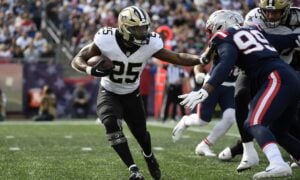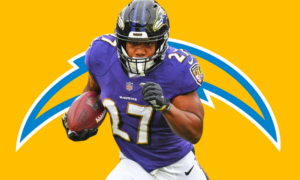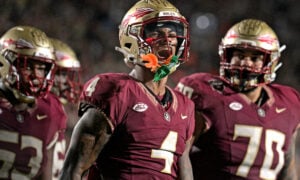2013 Rookie Analysis: Running Backs
Editor’s Note: A whole host of you signed up the Annual Premium Content package when it was first unveiled on April 21st of last year. To avoid any interruption in service, just click here to view your Premium account status, see how many days you have remaining on your subscription or renew. When you renew, it simply adds 12 months on to your current annual subscription, so don’t be concerned if you commit early.
In the second part of my series, I look at the 2013 group of incoming rookie running backs.
We’ve already looked at the quarterbacks and have found a largely underwhelming selection. Much in the same vein, this year’s running backs, too, leave a lot to be desired in the front end of the class. But that is not to say that there isn’t a good level of talent across the group, more that it isn’t loaded at the top with an even distribution as we progress through the rankings. Without an elite tier-one headliner or two, a lot is left open for interpretation if you hold a top pick in this year’s draft. Conversely, if you hold a pick in the second half of the first round, or second round selections, there’s plenty to be excited about. The stratification is such that the talent is evenly distributed across all the positions allowing for later picks to hold nearly as much intrigue and potential as the first five picks. 2013 will be an interesting study in retrospect three-to-five years from now.
These rankings may be adjusted due to drafted situation but, as of this writing, are based upon my assessment of skill to NFL impact potential without regard to system or team placement.
Running Backs
When analyzing running backs, there are many categories and traits I look for, but unlike my strategy when analyzing quarterbacks, I don’t settle on any single, or small set, of characteristics toward determining predicted impact in the NFL. There are many, many combinations of skills and traits that, when combined with system and team placement, can make for star potential under the right circumstances. While this is true with all positions to some degree, I’m a firm believer the running back position is far less a science, at least when predicting future impact. This is the same belief system that leads certain Head Coaches (such as Mike Shanahan) to rarely select a running back highly in the draft due to his confidence in finding system runners much later … and with a great deal of success.
All that said, if pressured, I would offer that my most targeted traits are:
1) Size/Build
2) Lateral Agility/Hips
3) Speed/Acceleration
4) Vision
5) Patience
Secondarily, but very close in importance:
1) Work Ethic/Character
2) Hands
3) Pass Protection
4) Pad Level
5) Running Style/Aggressiveness
Note that I could give you another ten traits of importance, any one of which could significantly drop a back in my rankings, but this gives you a general idea of what I’m looking at when watching tape.
1. Eddie Lacy
Alabama
5’11″/231 Lbs.
There’s a lot to like about Alabama’s Eddie Lacy. I had him pegged as the country’s best runner, at least in my own eyes, in the middle of the 2012 season. But as much as I like what he brings to the table, there are plenty of question marks as well. In my view, he’s not elite, but is a very good back. Nor do I think he’s a lock to be drafted in the first round of the NFL Draft.
Passing the first test, his college yards per carry (YPC) average was a healthy 6.8 which, for anyone who has seen Lacy run, will come as no surprise. He also tallied 30 touchdowns over his past three years on ever-increasing workload, ultimately scoring 17 of them in 2012. His hands out of the backfield are passable, yet not the strength of his game.
He’s relatively stiff in the hips, but displays good patience, body lean and the ability to get his shoulders downhill quickly enough to hit holes and seams. His game is dependent on a good offensive line and forward momentum. His speed is good for his size and he rarely loses yardage at the point of attack. In traffic, his base gets too narrow and his footwork displays his lack of agility and hip swivel, but he has the potential to pound out yardage after contact if not squared up. He reminds me a bit of Michael Turner in his later years, but not with Turner’s better than average agility for his size early in his career.
Lacy is without a doubt the best candidate at the position for fantasy teams needing running back help. I don’t see him as an elite prospect, or even as a first tier player, but in the right system he could produce well. He’ll be a first round selection in all likelihood for a team such as Green Bay or perhaps even as early as the middle of the first round to a team such as Pittsburgh (#17) or Cincinnati (#21). In the end, I believe he’ll be a bottom-third selection in round one of the NFL Draft.
[vsw id=”4BodFlkOqog” source=”youtube” width=”425″ height=”344″ autoplay=”no”]
2. Giovani Bernard
North Carolina
5’8″/202 Lbs.
Bernard has the base I like to see in running backs who are successful at the NFL level. Thick legs and a good driving motor in that base allow him to have the leverage and power not seen in many backs at his size. In traffic, Bernard displays great balance and that wide base allows him to retain power and drive directionally to churn out yardage. He has better than average agility, a nice jump cut and a productive spin move that he uses at appropriate times. He’s quicker than fast, but efficient in that quickness rather than overly dynamic – this is likely due to his thicker build below the waist.
He’s got soft hands out of the backfield and will be utilized on third downs in the NFL, but he has toughness beyond a third down only back, perhaps leading to even greater usage. In pass protection, he has a lot of work to do. For a runner who runs much larger than his size, his pass protection is that of a much lighter back, too often throwing his body at the feet of oncoming rushers and not using his great base to disrupt the rusher.
He reminds me a bit of Doug Martin with less downhill power, but he also reminds me a lot of a back I liked out of college who never amounted to anything in the NFL, Nebraska’s Brandon Jackson. He’s still likely to be paired with a larger back in the NFL as part of a thunder and lightning tandem.
[vsw id=”u_frTZ6weTQ” source=”youtube” width=”425″ height=”344″ autoplay=”no”]
3. Johnathan Franklin
UCLA
5’10″/205 Lbs.
Franklin, much like Bernard, has a good base but without the sheer strength. He naturally feels holes and slides effortlessly to the point of attack. He’s quicker through the hole than is Bernard but doesn’t display the same small-area foowork that allows him to drive for further yardage when in traffic. However, his Senior year of 1,819 yards and 13 touchdowns nearly doubled his collegiate production and his versatility increased greatly.
The more tape I watch of Franklin, the more I see NFL ability. He utilizes good angles to the hole and has sufficient speed to get to the corner. He displays good patience and good hips for noteworthy balance and agility. He’s not overly elusive, but his natural feel in the open field adds to his production and agility. Third down pass protection is likely going to be a concern at the next level as he shows effort but consistently poor technique.
What I like about Franklin, much like that of Bernard, is that as a low second-tier or high third-tier running back talent, they have a greater potential to be drafted into better offensive line performance by playoff teams. Backs like Franklin don’t have the sheer skill set or body of work that suggests he can take over a game, but can be a productive back if given an opportunity. He’ll be a first round selection in fantasy rookie drafts, perhaps in the lower first round. He’ll provide great value at that position with better upside than would be expected.
[vsw id=”Kqu06Tj9dTw” source=”youtube” width=”425″ height=”344″ autoplay=”no”]
4. Marcus Lattimore
South Carolina
5’11″/221 Lbs.
You spin the wheel, you take your chances -t hat quote comes from one of my favorite pinball games back in the eighties, but also applies to Lattimore in 2013. He’s one of those backs who I’ve followed from High School and have been waiting for his NFL opportunity to arrive. I wish his path would have been more traditional and less arduous. Good luck to him.
A first-tier, sure-fire first round talent before his horrific injury, I’m seeing Lattimore being drafted as early as 1.06 and as late as the middle second round. Depending on your team need, I could justify either pick or anything in between. In fact, if pushed to forecast his production in relation to his rookie fantasy selection, I’d be comfortable with a selection at 1.07, give or take a pick or two. In this draft, given the quality of offensive skill position talent as it sits, I believe Lattimore and his amazing work ethic is worth every bit of a earlier first round selection. When I say “earlier,” I mean early in the second half of the first round.
He plays bigger than his 221 pound weight and rarely loses yardage. He runs well behind his pads and isn’t overly agile, but has great vision to make the most of what the offensive line provides. He’s compact through the hole, runs with a wide base and gets his pads square in a hurry. Once through the hole, he shows better agility than would be expected, can jump cut or drop his hips effortlessly and never stops churning his legs. He’s not overly quick or fast, but was clearly the best back in the class until the injury.
I often don’t like to take huge risks in the first round, but given what we’ve learned about Lattimore’s progress and rehabilitation, I’d not shy away from him once the top prospects are off the board. And given further good news and a good drafted situation, I would not be against moving him up my board from this spot in my running back ranking. As good as he is when healthy, he’s even better when you factor in his elite character and work ethic. He’s an easy player to draft.
[vsw id=”_auUlmr3Saw” source=”youtube” width=”425″ height=”344″ autoplay=”no”]
5. Montee Ball
Wisconsin
5’11″/214 Lbs.
Ball had 77 touchdowns, a 6.2 yards per carry average and 5,410 rushing yards for Wisconsin. It’s one of the most impressive running back careers you’ll ever see. However, having run no better than a 4.66 forty yard dash at the combine have many writing him off. I fully expect that will be proven to be a big mistake.
For the record, I don’t see Ball as a dominating back at the next level, but I will not be surprised if he’s an extremely successful back or even winds up in the Hall of Fame. Yes, it’s a bold statement to make, but watching Ball on tape is all anyone needs to do toward understanding that a quality running back doesn’t need to possess world class speed to be successful. Ball has elite instincts with the ball in his hands, is patient, slides well and understands how to get small through holes and seams. He’s got perhaps more “will” of any back I’ve ever seen, especially close to the goal line.
He doesn’t have elite agility or hips, but runs well behind his pads and has nearly elite balance which allows him to absorb first contact and remain on his feet. In the open field, he understands how to use angles, show change of direction and set up his second move in order to maximize yardage. His hands are good enough in the passing game and he displays the same vision while moving forward while awaiting the pass. In pass protection, he’s not great, but he’s willing.
If he runs a 4.50 forty, he’s likely to be the first back off the board. Even still, without the long speed, I won’t be surprised if he’s the second back off the board as is. You can’t put together a back much better than Ball. If you want to knock him down due to speed, 924 carries for Wisconsin or the fact that he ran behind an offensive line larger than most in the NFL, I’m okay with that … but the criticisms can’t extend much beyond that.
He’ll be late first round selection in fantasy and I’d be “all in” at that position.
[vsw id=”7eaFp_pnrAs” source=”youtube” width=”425″ height=”344″ autoplay=”no”]
6. Christine Michael
Texas A&M
5’10″/22o Lbs.
If not for a checkered character history at A&M, Michael could be a first round NFL selection. As it stands, he’s the workout warrior for 2013 after a very impressive NFL Combine performance. He plays faster than his timed 4.54 forty, but was among the leaders in all other categories. He was never ultra productive in yardage for the Aggies, but did manage 34 touchdowns.
What I like most about Michael is his acceleration once he squares his pads to the line of scrimmage, especially on stretch plays. He’s patient behind his blockers but once the seam is visible, he’s through it more quickly than other backs in this class. Once in the open field, he’s got speed beyond his timed level and is a threat to score when in the secondary. He’s not overly agile, instead taking a very North/South approach and preferring to deliver punishment. He’s not overly productive out of the backfield in the passing game and his pass protection is passable or average at best.
Many have Michael off the board in the second round of the NFL draft, but I believe he’ll be a third round choice due to character and work ethic concerns. In fantasy, he’ll be off the board late in the first round if his drafted situation is noteworthy (Green Bay, Pittsburgh, Denver, etc.), otherwise expect an early second round fantasy selection.
[vsw id=”l52K5QZ2OEw” source=”youtube” width=”425″ height=”344″ autoplay=”no”]
7. Le’Veon Bell
Michigan State
6’1″/230 Lbs.
Over 6’1″ and at 230 pounds, Bell is a force to be reckoned with when the ball is in his hands. Given his size, it’s a bit surprising he only averaged 5.0 yards per carry for his career. To make things worse, in 2012 he could only muster 4.7 yards oer carry on 382 carries.
As a runner, Bell is a punishing runner who uses his size to his advantage. What’s surprising about Bell is that, given his size, he has a nice level of agility that allows him avoid being single dimensional in his running. Make no mistake, he’s a downhill runner who looks to keep his shoulders square to the line of scrimmage at all times. He tends to run very high, is somewhat stiff in the hips and isn’t going to avoid a lot of tackles from more agile tacklers, but they had better bring better leverage.
Adding to his allure in the pros is the fact that not only is he a willing blocker, but he’s relatively adept in pass protection, using his size to gain leverage. He’ll be a nice selection for a team with a capable third down back already in place as a complement to his skills.
[vsw id=”9o2nDhwiWeE” source=”youtube” width=”425″ height=”344″ autoplay=”no”]
8. Knile Davis
Arkansas
5’10″/227 Lbs.
Granted, I’m a bit of a sucker for the workout warrior, especially when they have great size and incredible speed. Davis put his name on the map when he was able to run a 4.37 forty during the NFL Combine. Aside from that, he’s somewhat of an enigma as a runner. What isn’t an enigma is his proclivity toward fumbling and injury. Recurring ankle and collarbone injuries from High School on have limited his productivity.
For a big back, Davis doesn’t show a desire to take on would be tacklers with better leverage and power, instead relying upon his agility and speed to elude tacklers. I’d like to see more power through the hole and first contact, but Davis shows the ability to run through arm tackles through his acceleration. Once in the open field, he’s tough to bring down due to his ability to get into, and utilize, space to his advantage. He needs work in pass protection and has tier one fumbling and injury issues that will need to be dealt with at the next level.
His upside is huge and he reminds me of Herschel Walker in some respects, although without the level of aggression and toughness.
[vsw id=”zRLW_EbJcUg” source=”youtube” width=”425″ height=”344″ autoplay=”no”]
9. Zac Stacy
Vanderbilt
5’8″/216 Lbs.
Stacy did his best Maurice Jones-Drew impression at the combine, running a noteworthy 4.55 forty at 5’8″ and 216 lbs. He has a huge lower body, extremely effective base and good running instincts that allow him to locate good angles through the hole and into the secondary. His size and short steps are problematic for defenders at his feet and while he won’t run away from many defenders in the NFL, he’s got enough speed, when combined with his lower body leverage, to be productive.
We’re to the point where all backs selected will be questionable relating to long term potential, but I love Stacy’s potential as a sleeper for fantasy coaches with a roster spot and time to give.
[vsw id=”b9L8lAbcN4A” source=”youtube” width=”425″ height=”344″ autoplay=”no”]
10. Kenjon Barner
Oregon
5’9″/196 Lbs.
Barner simply looks and runs thicker than his listed weight – that may explain the slower than expected in the forty (4.52). For a smaller back, he shows the willingness to get downhill quickly, but just as often will bounced runs outside. However, I do like that he looks inside first before looking to bounce. He’s strong enough to run through arm tackles while accelerating and he doesn’t shy away from contact. There looks to be room for added weight on his frame which should help at the next level.
On tape, he’s exactly what you expect. He has a decent base, great lateral agility and a nice hip-swivel, where the hips float below the torso to accept contact, keep balance and provide for change of direction. The addition of ten pounds may take away from Barner’s elusiveness and I look for NFL teams to keep him as a return specialist combined with spot rushing duty similar to Jacquizz Rodgers in Atlanta. There’s not a lot of mystery with Barner and he’s likely a late second round selection in fantasy depending on drafted situation.
[vsw id=”KzB7K8JhFZw” source=”youtube” width=”425″ height=”344″ autoplay=”no”]
11. Joseph Randle
Oklahoma State
6’0″/204 Lbs.
I was excited to see more of Randle during the NFL Combine as well as doing a fair amount of tape study as I didn’t get to see him play as often as I would have liked. Broadly speaking, while he has talent, what I’ve seen has been disappointing and it’s a bit of a mystery to me that he hasn’t been able to accomplish more given his listed size. Take that for what it is, however, as Randle did amass 40 touchdowns while at Oklahoma State and averaged 5.5 yards per carry while catching 108 balls out of the backfield. Clearly he has upside and will make for a good risk-reward play on draft day, both during the NFL Draft and in fantasy.
I was really surprised at his slower (4.63) forty, but on film his long striding style and single speed are evident. Not that he’s slow on tape, but he’s certainly a single speed runner and I frequently was waiting for a second gear to become evident, which it never really did. When he gets to full stride, he does eat up yardage quickly, but I fear he’ll have issues getting through the line of scrimmage in the pros. He’s not particularly thick at the base and runs very high. He’s not particularly agile with very little lateral agility and somewhat stiff in the hips as well.
On the positive side, he also runs with a certain level of aggression, doesn’t avoid contact and usually has a good body lean for extra yardage. Additionally, he’s a willing and capable in pass protection, utilizing good leverage at the point of attack. He has a high ceiling considering his pre-draft value and he’s as much of a mystery to me as any player. There’s one last positive note in that he reminds me a bit of DeMarco Murray of Dallas. Murray is another player who I was not high on coming out of college due to durability and running style. So there is potential here.
[vsw id=”cn3xjdLGUm4″ source=”youtube” width=”425″ height=”344″ autoplay=”no”]
12. Andre Ellington
Clemson
5’9″/199 Lbs.
Ellington is another player who I came away disappointed with following tape review and the NFL Combine and most remain higher on him than I am. When reviewing tape, I can see how many will give him the benefit of the doubt in some situations, but in the NFL where defenses are punishing and swarming, mistakes and exploitable characteristics will usually keep running backs on the bench.
NFL.com likened Ellington to Jahvid Best and I just can’t find the dynamic for that comparison. He does have a second gear he uses at appropriate times as he’s able to burst through defenders. He also has relatively quick feet and lateral agility, with the ability to dive and redirect rather adeptly. He’s not overly thick below the waist, but does show some mass that is visible on occasion. He’s not overly creative as a runner and doesn’t possess (or doesn’t display) the second dimension I like to see in dynamic backs. Ellington will sometimes chop his feet in traffic or as he approaches contact, but other times shows the willingness to to stride into traffic.
Many runs I see the dynamic runner I like to see with good balance and smooth hips, but inconsistency in all phases of his game gives me pause. There’s no doubt he pops off some very nice runs, but I can’t rank him highly. The clip below will leave you with a slack jaw often, but in other tapes, he’s very mediocre. He’ll be worth a second round fantasy selection and could fall further depending on situation.
[vsw id=”9TbowLHph4A” source=”youtube” width=”425″ height=”344″ autoplay=”no”]
The Rest
Mike Gillislee
Florida
5’11″/208 Lbs
It’s a tie between Gillislee and Wood as my favorite sleeper. He’s a downhill runner, doesn’t possess a lot of dynamic ability, but has a nice level of vision and second gear.
[vsw id=”UUHMKSzhjpI” source=”youtube” width=”425″ height=”344″ autoplay=”no”]
Cierre Wood
Notre Dame
5’11″/213 Lbs
Questions remain about Wood’s character and work ethic, two traits I steer away from. But his tape is good enough to be in the top ten regardless. Caveat Emptor.
[vsw id=”jqOJ14d7t3Q” source=”youtube” width=”425″ height=”344″ autoplay=”no”]
Stepfan Taylor
Stanford 5’9″/214 Lbs.
I like him as an overall player, but there’s just too much mediocrity across the board to be great in the NFL. Would like to see him get his chance, but he’s not great in any one area.
[vsw id=”7LXyVI6nLdU” source=”youtube” width=”425″ height=”344″ autoplay=”no”]
Next up, the wide receivers!
- Lineup Advice: Wrap-up, Thank You and Goodbye (TTFN) - January 1, 2024
- Lineup Advice: Week 17 – Championship Edition - December 26, 2023
- Lineup Advice: Week 16 – The “What is” Edition - December 19, 2023


































































